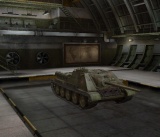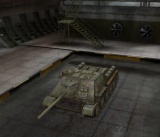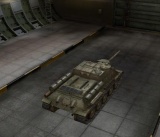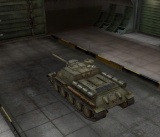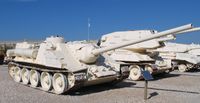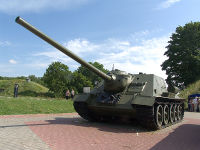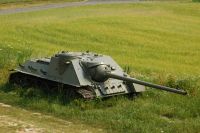SU-100
| Revision as of 20:01, 28 February 2012 | Revision as of 20:02, 28 February 2012 | |||
| Line 53: | Line 53: | |||
| [[File:SU100-b.jpg|160px|T95_001]] | [[File:SU100-b.jpg|160px|T95_001]] | |||
| [[File:SU100-c.jpg|160px|T95_001]] | [[File:SU100-c.jpg|160px|T95_001]] | |||
| ? | [[ | + | [[File:SU100-d.jpg|160px|T95_001]] | |
| }} | }} | |||
| {{History|info= | {{History|info= | |||
Revision as of 20:02, 28 February 2012
SU-100
| USSR | TD | Tier VI |
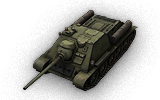
The SU-100 is a Soviet tier 6 tank destroyer which performs like the SU-85, but has more armor and a much more powerful gun. Unfortunately, none of the SU-85 guns carry over to the SU-100, except for its starting 85mm D-5S gun. The 85mm D-5S shows its weakness when fighting tier 7 tanks above. You can choose to get an improved 85mm, but it is typically skipped by most players as it is not inline to the SU-152 upgrade. The 100mm D10S is suitable for killing fast moving tanks, thanks to its high rate of fire and acceptable penetration power. Finally, you'll gain the option to equip the 122mm D-2-5S, which painfully stings heavy tanks at the expense of fire rate and accuracy.
- The SU-100 leads to the SU-152.
Modules
Historical Info
The SU-100 was a Soviet tank destroyer. It was used extensively during the last year of World War II and saw service for many years afterwards with the armies of Soviet allies around the world.
Development
It was developed in 1944 as an improvement to the SU-85, built on the same chassis as the T-34-85 tank. It was designed and built at the UZTM (Russian abbreviature УЗТМ for Уральский Завод Тяжелого Машиностроения - Ural Heavy Machinery Factory, also called Uralmash) in Yekaterinburg. The SU-100 quickly proved itself to be among the best self-propelled anti-tank guns of World War II, able to penetrate 125 mm (4.9 in) of vertical armor from a range of 2,000 m (1.2 mi) and the sloped 85 mm (3.3 in) front armor of the German Panther from 1,500 m (0.93 mi).[citation needed] This was quite capable of defeating any German tank in service, for which Soviet soldiers gave it the obscene nickname "Pizdets vsemu" ("Fucking end to anything").[1] The development was conducted under supervision of L. I. Gorlitskiy, chief designer of all medium Soviet self-propelled guns. The work started in February 1944, and the first prototype of SU-100, called "Object 138", was built in March. After intensive testing with different models of the 100 mm gun, Soviet engineers approved the D-10S gun for mass production. This gun was developed in Constructors Bureau of Artillery Factory No. 9 under guidance of F. F. Petrov. After the Second World War, it was installed on T-54 and T-55 tanks and its derivatives were in service forty years after initial development. The hull of the SU-100 had major improvements over the SU-85; thickness of front the armour plate was increased from 45 to 75 mm (1.8 to 3.0 in), and the commander's workplace was made in a small sponson on the right side of the hull. Combined with the commander's cupola, this greatly improved the commander's effectiveness. For better ventilation, two ventilator units were installed instead of only one as in the SU-85. Mass production began in September 1944.
In service
The SU-100 saw extensive service during the last year of the war. It was used en masse in Hungary in March 1945, when Soviet forces defeated the German Operation Frühlingserwachen offensive at Lake Balaton. By July 1945, 2,335 SU-100s had been built. The vehicle remained in service with the Red Army well after the war: production continued in the Soviet Union until 1947 and into the 1950s in Czechoslovakia. It was withdrawn from Soviet service in 1957, but many vehicles were transferred to reserve stocks. Some exist to this day in the Russian Army holding facilities. Many Warsaw Pact countries also used the SU-100, as did Soviet allies such as Egypt, Angola, and Cuba. The SU-100 saw service in the fighting that accompanied the 1956 Suez Crisis, in which the Egyptians used SU-100s against Israel's M4 Sherman tanks. The vehicle was also utilised in the 1967 Six-Day War and the 1973 Yom Kippur War. It was modified slightly to adapt it to the sandy conditions of the Middle East, thus creating the SU-100M variant. Exported SU-100s continued in service until the 1970s, and in some countries, even later. The SU-100 remains in use by the Vietnam People's Army and the Korean People's Army Ground Force despite the age of the design. SU-100s entered service with the People's Liberation Army (PLA) of China in 1955 after Soviet forces left Dalian. The armaments in Dalian were sold to China, including 99 SU-100s, 18 IS-2 heavy tanks, 16 T-54s and 224 T-34s, with which PLA formed into the 1st Mechanised Division.
In popular culture
The crew of a World War II SU-100 and their vehicle are the heroes of the old Soviet film «На войне как на войне» Na vojne kak na vojne ("Alls fair in love and war" (literally: "In wartime its like wartime")), one of several Soviet films made about self-propelled artillery men. Veterans of the German-Soviet War found this picture quite realistic. The movie includes a [Soviet tankmen song], which is popular with both Russian armoured soldiers and civilians.
| Light Tanks | MS-1 • BT-2 • Tetrarch • T-26 • T-60 • BT-7 • BT-SV • LTP • M3 Light • T-127 • T-46 • T-70 • A-20 • T-50 • T-80 • Valentine II • T-50-2 • MT-25 |
| Medium Tanks | A-32 • T-28 • Matilda IV • T-34 • T-34-85 • A-43 • KV-13 • T-43 • A-44 • T-44 • Object 416 • T-54 • Object 430 II • Object 283 • T-62A • Object 140 • Object 430 |
| Heavy Tanks | Churchill III • KV • KV-1 • KV-220 • KV-220 Beta-Test • KV-1S • KV-2 • T-150 • IS • KV-3 • IS-3 • IS-6 • KV-4 • KV-5 • IS-8 • ST-I • IS-4 • IS-7 |
| Tank Destroyers | AT-1 • SU-76 • SU-85B • SU-85 • SU-85I • SU-100 • SU-100Y • SU-100M1 • SU-122-44 • SU-152 • ISU-152 • SU-101 • Object 704 • SU-122-54 • Object 263 • Object 268 |
| Self-Propelled Guns | SU-18 • SU-26 • SU-5 • SU-122A • SU-8 • S-51 • SU-14-1 • SU-14-2 • 212A • Object 261
|





